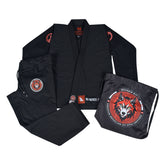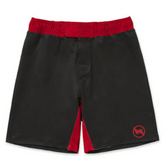BJJ Gi Patches Placement – Detailed Guide
In the world of Brazilian Jiu-Jitsu (BJJ), a practitioner's Gi is more than just a uniform. It is a symbol of identity, dedication and style. One of the most personalized elements of a BJJ Gi is the placement of patches. It does not matter if you are representing your academy, a sponsor or simply expressing your personality. Patches are a great way to customize your Gi. But it is not all freestyle creativity. IBJJF regulations set clear standards on where patches can be placed, what sizes are acceptable and which placements are strictly prohibited during competition.
In this detailed guide, we will cover everything you need to know about BJJ Gi patch placement. This will include IBJJF legal guidelines, recommended patch sizes and strategic customization tips that keep you compliant and stylish.
Why Do BJJ Practitioners Use Gi Patches?
Gi patches serve multiple purposes in the Brazilian Jiu-Jitsu community:
- Academy Representation: Most academies encourage or require students to wear patches with their logos.
- Sponsorship: For competitors, patches often advertise sponsors and brands.
- Personal Expression: Some athletes use custom patches to reflect their personality, origins or philosophies.
- Team Unity: Matching patches help build team identity during competitions.
But even with all these creative options, when it comes to IBJJF competitions, placement and sizing must follow strict rules.
IBJJF Patch Regulations: What’s Legal and What’s Not
The International Brazilian Jiu-Jitsu Federation (IBJJF) has a well-defined rulebook. It dictates patch placement on the Gi for all official competitions. Failure to comply can result in disqualification before a match even begins.
Allowed Patch Placement Zones
According to the IBJJF 2025 Rulebook, patches are only allowed in specific areas of the BJJ Gi:
Jacket (Kimono Top):
- Upper Left Front Panel (chest)
- Upper Right Front Panel (chest)
- Shoulders (left and right)
- Upper Back (below collar)
Pants:
- Front of Upper Thighs (left and right)
- Sides of Thighs (left and right)
Prohibited Patch Zones
Patches placed on the back of the sleeves, lower back, collar, cuffs or inside the Gi are considered illegal. And these may result in disqualification or a mandatory Gi change.
Recommended Patch Sizes (Per IBJJF Rules)
While IBJJF does not specify exact maximum patch sizes for each area, your patches must be:
- Properly sewn (no peeling edges)
- Soft and flexible (no hard materials or adhesives)
- Not interfere with grips, mobility or performance
Here is a general guideline used by most compliant patch manufacturers:
| Gi Area | Max Recommended Patch Size |
|---|---|
| Chest (left/right) | 4" x 4" (10cm x 10cm) |
| Shoulders | 6" x 2.5" (15cm x 6cm) |
| Upper Back (below collar) | 12" x 4" (30cm x 10cm) |
| Front Thigh (pants) | 6" x 6" (15cm x 15cm) |
| Side Thigh (pants) | 12" x 3" (30cm x 7.5cm) |
Always check your Gi with patches in a mirror or photo to ensure balance and compliance.

Tips for Proper BJJ Gi Patch Application
1- Sew, Don’t Stick
Avoid adhesive or iron-on patches. IBJJF requires patches to be sewn securely along all four edges. Use strong thread and double-stitch for longevity.
2- Avoid Grip Interference
Ensure no patch is placed where opponents may grab, like sleeve cuffs or lapels. Misplaced patches can result in match delays or disqualification.
3- Pre-Tournament Inspection
Every IBJJF tournament includes a Gi check before the match. Ensure:
- Your Gi fits properly.
- Patches are securely sewn and placed only in legal zones.
- Patches are not frayed or peeling.
Do All Tournaments Follow IBJJF Rules?
Most major Brazilian Jiu-Jitsu competitions follow IBJJF standards. However, some local or non-IBJJF events may be more lenient or even more strict. Always check the event-specific ruleset beforehand.
Shop > IBJJF Appoved Bjj Gi.
Customizing BJJ Gi Patches Without Breaking the Rules
Here is how you can stand out on the mat while staying compliant:
- Academy Branding: Place your team’s patch on the chest or shoulder.
- Country Flags: A small national flag on the chest or pants is a subtle patriotic touch.
- Sponsor Logos: Add these to the thighs or upper back area.
- Inspirational Quotes or Icons: Keep them minimal and legally placed — inner lining prints (not patches) are a safe alternative.
What Happens If Your Patches Are Illegal?
At an IBJJF tournament, if your Gi patch placement is deemed illegal, you will be asked to change your Gi immediately. If you do not have a spare compliant Gi, you could forfeit your match. That is why it is critical to double-check placement and sizing before competition day.
Final Thoughts: Make Your Gi Yours—The Right Way
Customizing your BJJ Gi with patches is a great way to express your identity, showcase your team and honor sponsors. But it is only if done right. IBJJF rules are strict, but not restrictive. With smart design and correct patch placement, you can compete confidently and in style.
So, does not matter whether you are a white belt just starting out or a seasoned black belt with sponsors and accolades. Make your Brazilian Jiu-Jitsu Gi your own—with patches that respect the art and the rules.
Frequently Asked Questions (FAQ)
Q: Can I use velcro patches on my BJJ Gi?
A: No, IBJJF does not allow velcro or adhesive patches. All patches must be sewn securely.
Q: Are brand logos that came with the Gi allowed?
A: Yes, as long as they are in legal zones and do not interfere with competition grips.
Q: How many patches can I put on my Gi?
A: As many as you like, as long as they are placed in the allowed zones and meet size/material requirements.
By understanding and respecting patch placement rules, you not only avoid disqualification. But you demonstrate your professionalism and respect for Brazilian Jiu-Jitsu tradition.





